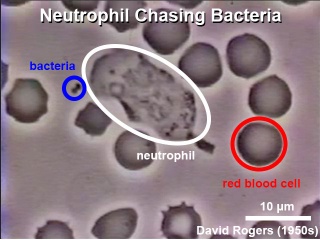Movie - Neutrophil chasing bacteria
| <html5media height="520" width="640">File:Neutrophil chasing bacteria movie.mp4</html5media> |
|
- Links: MP4 movie | Unlabeled MP4 movie | Neutrophil chemotaxis movie | Neutrophil extracellular trap movie | Bacterial Infection | Movies
About the Movie
This video is taken from a 16-mm movie made in the 1950s by the late David Rogers at Vanderbilt University. It was given to Thomas P. Stossel via Dr. Victor Najjar, Professor Emeritus at Tufts University Medical School and a former colleague of Rogers.
It depicts a human polymorphonuclear leukocyte (neutrophil) on a blood film, crawling among red blood cells, notable for their dark color and principally spherical shape. The neutrophil is "chasing" Staphylococcus aureus microorganisms, added to the film.
The chemoattractant derived from the microbe is unclear but may be complement fragment C5a, generated by the interaction of antibodies in the blood serum with the complement cascade, and/or bacterial N-formyl peptides. Blood platelets adherent to the underlying glass are also visible. Notable is the characteristic asymmetric shape of the crawling neutrophil with an organelle-excluding leading lamella and a narrowing at the opposite end culminating in a "tail" that the cell appears to drag along. Contraction waves are visible along the surface of the moving cell as it moves forward in a gliding fashion. As the neutrophil relentlessly pursues the microbe it ignores the red cells and platelets. However, its leading edge is sufficiently stiff (elastic) to deform and displace the red cells it bumps into.
The internal contents of the neutrophil also move, and granule motion is particularly dynamic near the leading edge. These granules only approach the cell surface membrane when the cell changes direction and redistributes its peripheral "gel." After the neutrophil has engulfed the bacterium, note that the cell's movements become somewhat more jerky, and that it begins to extend more spherical surface projections. These bleb-like protruberances resemble the blebs that form constitutively in the M2 melanoma cells missing the actin filament crosslinking protein filamin-1 (ABP-280) and may be telling us something about the mechanism of membrane protrusion.
Text: Thomas P. Stossel (Brigham and Women's Hospital and Harvard Medical School), June 22, 1999
Unlabelled Version
<html5media height="520" width="640">File:Neutrophil chasing bacteria movie2.mp4</html5media>
About the Cells
Neutrophil
| Blood Smear Slide | Neutrophil |
|---|---|
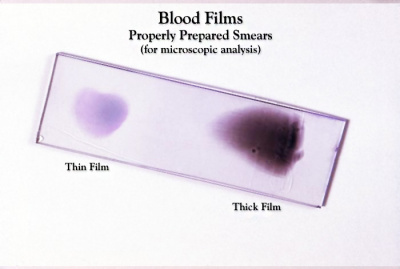
|

|
Red Blood Cell
| RBC histology | RBC Scanning Electron Micrograph (SEM) |
|---|---|
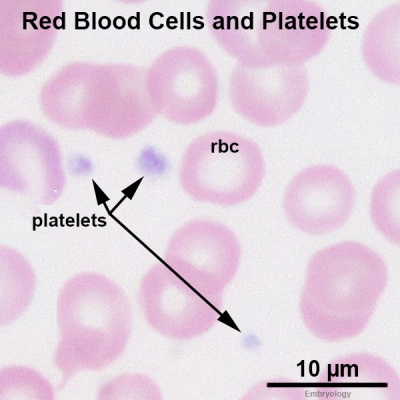
|
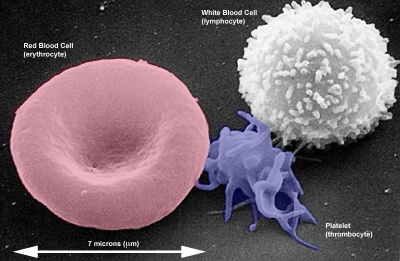
|
Adult human red blood cells during their 100 day life in circulation gradually loose up to 30% of their volume[1]
Staphylococcus aureus
| Staphylococcus aureus (SEM) | Bacterial morphologies |
|---|---|

|
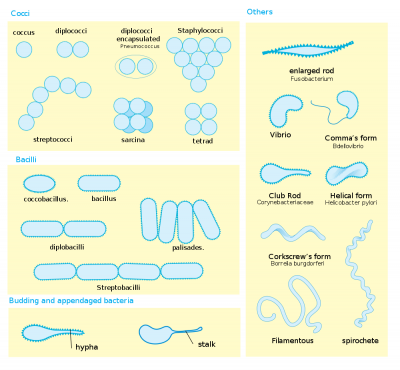
|
| Image[2] | "coccus" - spherical |
The bacteria staphylococcus aureus are classified as non-motile[3], but do appear to have mechanisms that allow movement.[4]
References
- ↑ Malka R, Delgado FF, Manalis SR & Higgins JM. (2014). In vivo volume and hemoglobin dynamics of human red blood cells. PLoS Comput. Biol. , 10, e1003839. PMID: 25299941 DOI.
- ↑ Otto CC, Cunningham TM, Hansen MR & Haydel SE. (2010). Effects of antibacterial mineral leachates on the cellular ultrastructure, morphology, and membrane integrity of Escherichia coli and methicillin-resistant Staphylococcus aureus. Ann. Clin. Microbiol. Antimicrob. , 9, 26. PMID: 20846374 DOI.
- ↑ Henrichsen J. (1972). Bacterial surface translocation: a survey and a classification. Bacteriol Rev , 36, 478-503. PMID: 4631369
- ↑ Pollitt EJ, Crusz SA & Diggle SP. (2015). Staphylococcus aureus forms spreading dendrites that have characteristics of active motility. Sci Rep , 5, 17698. PMID: 26680153 DOI.
Terms
- complement fragment C5a acts in attraction of neutrophils (innate immune cells). Cleavage of complement component C5 by protease C5-convertase results in the C5a and C5b fragments. C5a can also act as an inflammatory peptide, encouraging complement activation, formation of Membrane Attack Complex (MAC), and histamine release involved in allergic responses.
- formyl peptide receptors (FPRs) are G-protein-coupled receptors (GPCRs) present on neutrophils that function as chemoattractant receptors in innate immune responses.
Glossary Links
- Glossary: A | B | C | D | E | F | G | H | I | J | K | L | M | N | O | P | Q | R | S | T | U | V | W | X | Y | Z | Numbers | Symbols | Term Link
Cite this page: Hill, M.A. (2024, April 27) Embryology Movie - Neutrophil chasing bacteria. Retrieved from https://embryology.med.unsw.edu.au/embryology/index.php/Movie_-_Neutrophil_chasing_bacteria
- © Dr Mark Hill 2024, UNSW Embryology ISBN: 978 0 7334 2609 4 - UNSW CRICOS Provider Code No. 00098G
